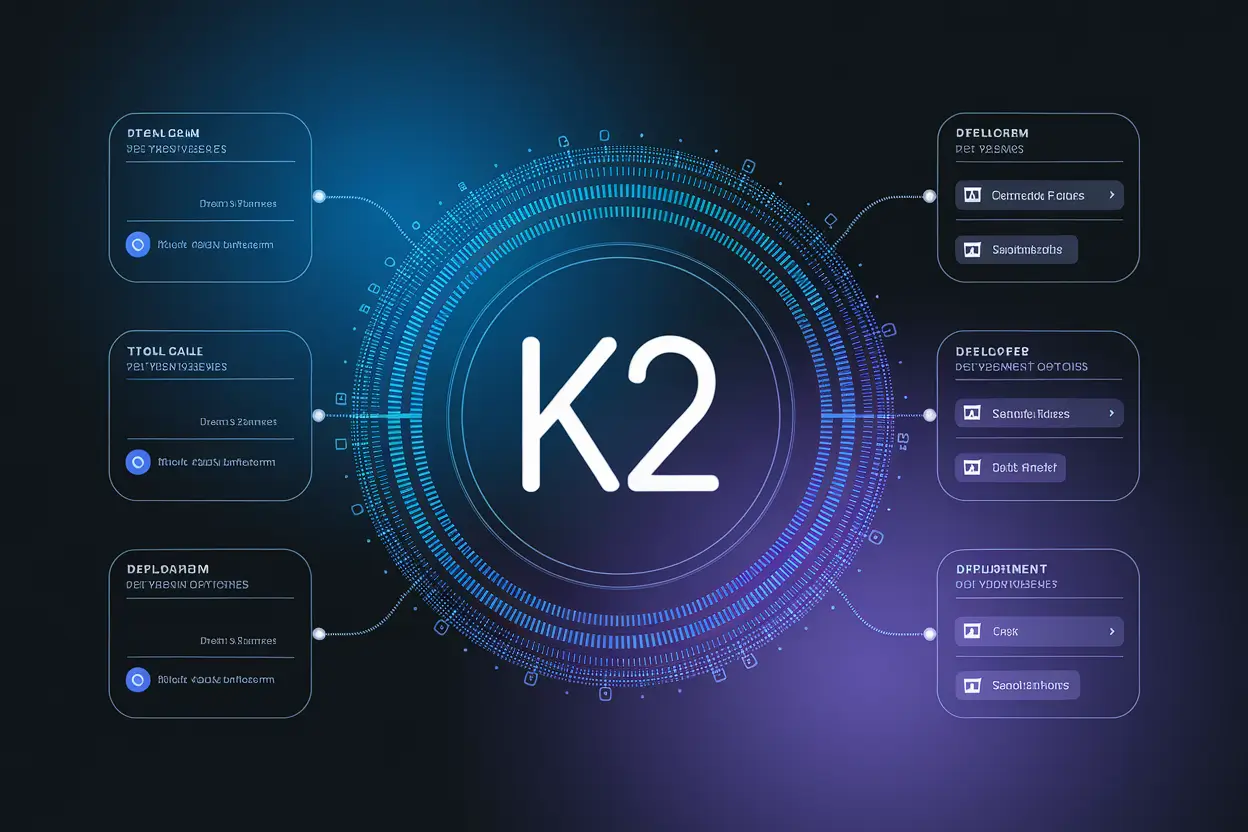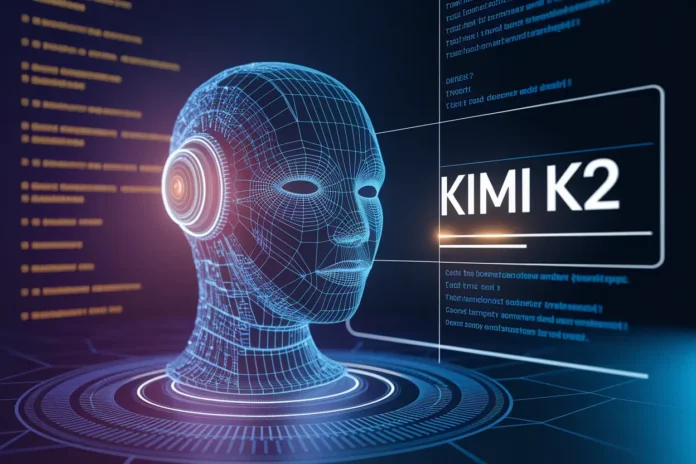Kimi K2 is at the forefront of innovation in the open-source artificial intelligence landscape, emerging as a game-changing large language model developed by Chinese startup Moonshot AI. Designed to compete with some of the industry’s biggest names, Kimi K2 combines power, speed, and accessibility, setting a new standard in AI coding, mathematics, and agent-assisted tasks.
What is Kimi K2 and Why It Matters
Kimi K2 is a large language model (LLM) engineered to handle complex agentic functions, mathematical processes, and code generation tasks. Developed by Moonshot AI in March 2023, the model distinguishes itself through its Mixture-of-Experts (MoE) architecture. This system activates specific experts to address particular problems, allowing only 32 billion out of its total 1 trillion parameters to be active during inference. This dramatically enhances inference efficiency without compromising performance.
Kimi K2 Focus Keyword in Architecture
Kimi K2‘s MoE framework is a strategic innovation allowing for reduced computational cost during training and faster token inference during deployment. Instead of a monolithic LLM managing each task, Kimi K2 intelligently chooses from a series of ‘experts’ tailored to different domains. This architectural design allows it to dynamically adapt to multiple tasks without requiring constant reconfiguration.
Kimi K2 and Its Revolutionary Optimizer: MuonClip
The MuonClip Optimizer used in Kimi K2 replaces the widely used Adam optimizer. It addresses core issues in trillion-scale parameter models like attention logit bias and token inefficiency. This change not only improve stability but also the overall cost-efficiency of training and inference cycles, making Kimi K2 viable for enterprise-grade deployments.
Key Metrics and Training Data Scale
Kimi K2 was trained on a staggering 15.5 trillion tokens of data, dwarfing the datasets used by many competitors. Its benchmark performance is telling—scoring 65.8% on SWE-bench Verified and 53.7% on LiveCodeBench, it not only surpasses DeepSeek V3 (46.9%) but also OpenAI’s GPT-4.1 (44.7%). Such achievements position the model as a serious contender in the generative AI domain.
Kimi K2 Integration in Software Development
One of the key applications of Kimi K2 is in the software development pipeline. From code generation to unit testing and debugging, developers can offload repetitive or cognitively heavy tasks onto the model. This makes it ideal for increasing productivity in DevOps environments, freelance software engineering, and even IDE plugins.
Kimi K2 Use in Advanced Mathematics
When it comes to complex problem-solving, Kimi K2 excels in math competitions and academic benchmarks. On MATH-500, it reached 97.4% accuracy—far outpacing GPT-4.1’s 92.4%. This makes it highly valuable for scientific research, educational toolkits, and even financial analysis requiring statistical modeling.
Kimi K2 for General Agentic Tasks
Kimi K2 is tailored for general agentic tasks such as task decomposition, tool calling, and autonomous decision-making. By utilizing large-scale agentic data synthesis, it can simulate and learn from multi-turn tool-use scenarios. This makes it a frontrunner for automating operational workflows in business process management and customer interactions.
Deployment Strategies Using Kimi K2
Accessing Kimi K2 is straightforward through its OpenAI/Anthropic-styled API at

. For self-hosting, Moonshot provides model checkpoints via Hugging Face. Developers are encouraged to use inference engines like vLLM, SGLang, KTransformers, and TensorRT-LLM to deploy with optimal efficiency. This diversified access model ensures businesses with varying technical capabilities can adopt the model.
Kimi K2 and Cost-Effective AI Solutions
Kimi K2 offers highly competitive pricing, charging just 15 cents for 1 million input tokens and $2.50 for 1 million output tokens. Compared to industry leaders like GPT-4.1 and Claude Opus 4, this presents an enticing option for startups and academic institutions seeking enterprise-class performance without inflating their operational costs.
Comparative Analysis: Kimi K2 vs Market Giants
| Model | LiveCodeBench Score | SWE-bench Verified | MATH-500 | Cost per 1M Tokens |
|---|---|---|---|---|
| Kimi K2 | 53.7% | 65.8% | 97.4% | $0.15 (input) / $2.50 (output) |
| GPT-4.1 | 44.7% | 63.3% | 92.4% | Varies (~$30) |
| Claude Opus 4 | — | — | — | ~$50 |
| DeepSeek V3 | 46.9% | — | 89.6% | $0.20 (input) |
Benefits of Open-Source Approach in Kimi K2
By releasing Kimi K2 as open-source software under a modified MIT license, Moonshot AI fosters transparency, scalability, and external innovation. Unlike proprietary models chained to usability restrictions, Kimi K2 enables researchers and developers to improve upon its architecture, fueling the growth of decentralized AI development globally.
Limitations and Challenges of Kimi K2
Despite its industry-leading features, Kimi K2 comes with limitations. The large-scale model demands high-end GPUs and extensive power resources for optimal performance. Additionally, it currently lacks multimodal input capabilities, limiting its use in applications like image+text analysis, video summarization, or voice-based agents.
Kimi K2 in the Chinese AI Ecosystem
Kimi K2 isn’t just a benchmark for AI capability—it also reflects China’s growing commitment to open-source AI development. Moonshot, along with companies like Tencent, Baidu, and Alibaba, is positioning itself for global influence by releasing highly capable open-source models. This is in stark contrast to U.S.-based AI firms like OpenAI and Google, which maintain closed-source policies for their premier models.
Using Kimi K2 in Enterprise Environments
Enterprises can use Kimi K2 for creating customized copilots, automating customer service with fine-tuned agents, and generating performance analytics. Its robust support for tool integration and reinforcement learning means the model can continuously improve based on accumulated enterprise-specific data, making it a long-term asset.
Future Roadmap for Kimi K2
Moonshot AI plans to enhance Kimi K2 with advanced thinking abilities and visual understanding. These enhancements will pave the way for AGI (Artificial General Intelligence), enabling the model to handle a broader set of sensory data inputs and decision-making frameworks. Future updates promise multimodal functionality to compete directly with PaLM-E and Gemini.
Real-World Use Cases of Kimi K2
- Academic Research: Solves high complexity math and generates academic language.
- eCommerce: Automates customer support & returns processing via agentic workflows.
- Legal Sector: Drafts and verifies contracts using its superior reasoning ability.
- Healthcare: Diagnoses symptoms based on historical learning, although verification is required due to regulatory compliance.
Conclusion: Why Kimi K2 Is a Landmark in Open-Source AI
Kimi K2 represents a watershed moment in open-source artificial intelligence. With its high benchmarks, cost efficiency, and scalable architecture, it stands out in a crowded market. Whether you’re a developer, researcher, or business leader, incorporating Kimi K2 can lead to tangible productivity gains and unlock smarter automation. At a time when the world debates the ethics of closed AI, Kimi K2 shines as a beacon of open-access technological progress.
FAQs About Kimi K2
What is Kimi K2?
Kimi K2 is a large language model created by Moonshot AI, built on a Mixture-of-Experts (MoE) architecture designed for coding, math, and agentic tasks.
Is Kimi K2 better than GPT-4.1?
In several benchmarks, Kimi K2 outperforms GPT-4.1, particularly in mathematical reasoning and coding tasks, all while offering more cost-effective deployment.
How can I access or deploy Kimi K2?
You can access Kimi K2 via its API at platform.moonshot.ai or download model checkpoints for self-hosting from Hugging Face. Recommended engines include vLLM and TensorRT-LLM.
What are the limitations of Kimi K2?
Current limitations include high resource requirements and the lack of multimodal input capabilities, which restrict its use in image or video processing tasks.
What license is Kimi K2 released under?
Kimi K2 is open-source under a modified MIT license, allowing for broad use in research and enterprise projects.



